Navigating the Atlantic Ocean
The offshore migration of hatchling Florida loggerheads is just the first step in a much longer transoceanic journey. Young loggerheads evidently remain for several years within the North Atlantic gyre, the circular current system that encircles the Sargasso Sea (see below). During this time many cross to the eastern side of the Atlantic Ocean before returning to the North American coast as juveniles.

The dark arrows on the map indicate the main currents of the North Atlantic gyre. Turtles remain within the gyre currents for several years as they grow and mature.
For young loggerheads, conditions within the North Atlantic gyre are favorable for survival and growth, but straying beyond the latitudinal extremes of the gyre is often fatal. As the northern edge of the gyre approaches Portugal, the east-flowing current divides. The northern branch continues past Great Britain and the water temperature decreases rapidly. Loggerheads swept north in this current soon die from the cold. Similarly, turtles that venture south of the gyre risk being swept into the south Atlantic current system and carried far from their normal range. An ability to recognize the latitudinal extremes of the gyre, and to respond by orienting in an appropriate direction, might therefore have considerable adaptive value.
How do young loggerheads migrating around the Atlantic for the first time find their way and avoid straying out of the gyre? Recent experiments have suggested a surprising answer: young turtles can apparently detect subtle differences in the magnetic fields that exist in different parts of the ocean and use these regional fields as navigational markers. To understand how this system works, let us first look at the Earth's magnetic field.
